.
12.08.2014
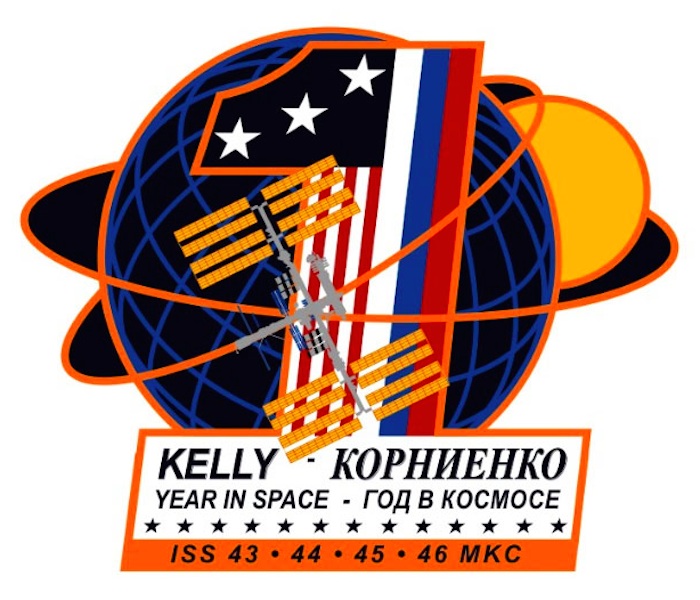
Scott Kelly is 7 months and 17 days from becoming the first NASA astronaut to spend a year in space.
Well, maybe not a full year, at least based on the currently published schedules.
Kelly and Russian cosmonaut Mikhail "Misha" Kornienko are slated to launch to the International Space Station on March 28, 2015 for the first yearlong expedition aboard the orbiting laboratory. They are scheduled to return to Earth 346 days later – 19 days shy of an entire year – on March 7, 2016.
"I made a deal with the station program, they'll extend that to make it a whole year, but that doesn't show up on paper yet," Kelly told collectSPACE.com in a recent interview. "It better be [a full year], although I could be regretting that when March 7 rolls around and I think I could be home."
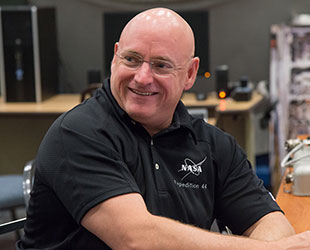
NASA astronaut Scott Kelly is pictured during a training session at NASA's Johnson Space Center in Houston, Texas. (NASA)
.
Full year or not, Kelly and Kornienko's expedition will set the record for the space station's longest mission in its 15-year history. Most crew members spend about five and a half months working and living on the outpost.
Only four people, all of them cosmonauts, have remained in orbit longer than a year during stays onboard the former Russian Mir space station.
During their 12 months in space, Kelly and Kornienko will be joined by a rotating contingent of four other astronauts and cosmonauts to conduct hundreds of experiments and to gather data to better prepare FUTURE crews for missions beyond Earth orbit, such as to Mars.
First though, Kelly and Kornienko have had to be prepare to spend a year off the planet. The two were appointed to the long-duration flight in 2012 and have been in training for the expedition since. It has only been recently though, that Kelly has started to notice the days ticking down to their launch.
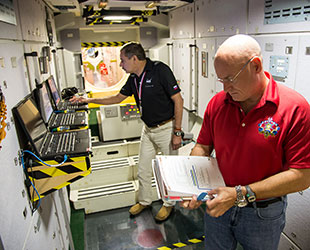
NASA astronaut Scott Kelly (foreground) and Russian cosmonaut Mikhail Kornienko participate in an emergency scenario training session in an International Space Station mock-up/TRAINER in the Space Vehicle Mockup Facility at Johnson Space Center. (NASA)
.
"As far the flight coming up quickly, I think it's just starting to feel that way for me," he told collectSPACE.com. "The BACKUP [crew] launch flow is August through September, which culminates with the Expedition 41 launch because I am [flight engineer Butch Wilmore's] backup."
"Then I am back in Houston for the month of October, in Russia in November, Japan in December, January back in Houston, February in Russia and then — space. So even though it is pretty much seven months away, it's going to happen pretty quick," Kelly OBSERVED.
At the 12 month mark in March, Kelly began a countdown with daily Twitter updates. Those posts have dropped off a bit since as the pace of preparations have picked up, and as Kelly's given thought to the effect of counting down, or up.
"I do recognize there is a risk to counting down — well, in this case, counting down isn't that risky, but counting the number of days until the end of the FLIGHT, or I was thinking of counting up days — a countdown [to launch] and then a count-up — there is obviously some risk in that as it could make the time seem to go by much more slowly," he said. "Maybe I will start counting up and then quit after awhile."
There are other ways Kelly might mark the year in space. He joked about not shaving for the length of his stay, but quickly abandoned that idea.
"All joking aside, I have considered taking pictures of the same spots on the Earth, as best as possible, to capture the changes over the period of a year. You know, on each continent, one SPOT," he explained.
Both he and Kornienko will visually mark the year another way, too. Borrowing a long-standing spaceflight tradition, the two now have their own commemorative mission patch to mark their yearlong journey.
"There is a big number one and it says 'Year in Space' and in Russian and English are Misha's and my names," Kelly said, describing the recently revealed emblem. "There is a picture of the space station over the Earth with the station going around the Earth and then the Earth going around the sun."
Quelle: CS
.
Update: 19.12.2014
.
Space station team eager to begin record yearlong flight
NASA astronaut Scott Kelly and Russian cosmonaut Mikhail Kornienko are gearing up for launch March 27 to kick off a record one-year stay aboard the International Space Station, an orbital marathon both men say is crucial for planning future flights beyond Earth orbit and, eventually, to Mars.
While four cosmonauts logged flights longer than one year between 1987 and 1999, the upcoming flight will be a first for the international lab complex and the first to focus on the long-term biological effects of the space environment using state-of-the-art medical and scientific research equipment and procedures.
"If we're ever going to go beyond low-Earth orbit for longer periods of time, spaceflight presents a lot of challenges to the human body with regard to bone loss, muscle loss, vision issues that we've recently realized people are having, the effect on your immune system, the effect of radiation on our bodies," Kelly said Thursday during a news conference in Paris. "Understanding those effects are very important.
"If a mission to Mars is going to take a three-year round trip, we need to know better how our body and our physiology performs over durations longer than what we've previously on the space station investigated, which is six months. Perhaps there's a cliff out there with regards to some of these issues that we experience and perhaps there aren't. But we won't know unless we investigate it."
A veteran of three previous space flights, including a shuttle mission to the Hubble Space Telescope and a 159-day stay aboard the station in 2010-11, Kelly is the twin brother of Mark Kelly, a retired astronaut who flew four shuttle missions and who is married to former congresswoman Gabrielle Giffords.
Kornienko also is a station veteran, logging 176 days aboard the outpost in 2010.
.
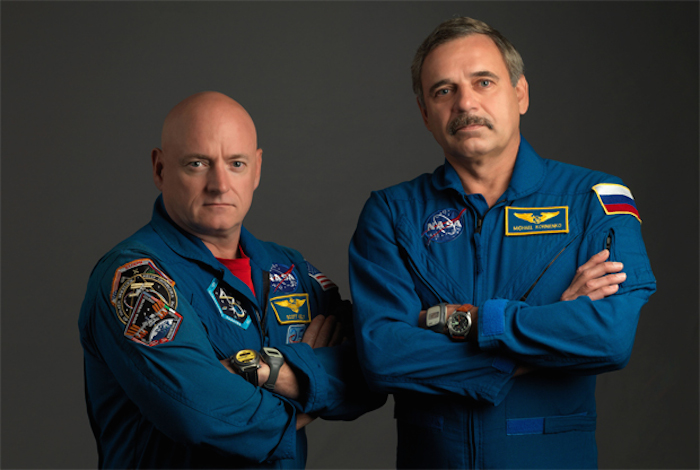
Astronaut Scott Kelly, left, and cosmonaut Mikhail Kornienko strike a pose during training for launch next year on a record year-long mission aboard the International Space Station. NASA
.
"The last long-time space mission was on the Mir (space) station and it brought major data for investigations and research about how humans will feel during long-term flights into space," he said. "I hope that our mission will be an opportunity for others who will follow in our footsteps and take space exploration further."
Kornienko said his wife cried before his last launch and cried again when he was named to the one-year crew. Asked how his daughter took the news, he smiled and said "she's 32, and you can congratulate me, I've become a grandpa!"
During their year aboard the station, major changes are planned including the installation of new docking adapters on two U.S. ports to accommodate commercial crew ferry craft being built by Boeing and SpaceX, work that will require the robotic relocation of a storage module. At least a half-dozen U.S. spacewalks are planned, including at least three by Kelly, and an unrelated Russian excursion that will include Kornienko.
The work will begin in late January and early February when two current crew members, Expedition 42 commander Barry "Butch" Wilmore and Terry Virts, carry out three spacewalks to pre-install wiring needed by the docking adaptors and new communications equipment that will be used by Boeing and SpaceX crews approaching and departing the space station.
"I'll be doing ... some of the spacewalks, some of the robotics and a lot of the internal reconfiguration," Kelly said. "Actually, we're starting to refer to it as the 'reassembly of the space station' because it does involve a lot of EVAs (spacewalks) and internal work on (the) wiring of the space station and moving (components) around. It's a lot of work, and I'll be involved in all of it. I really look forward to that, too."
But the primary focus is on research, serving as both operator and subject in a variety of experiments. In a Time Magazine cover story this week, Mark and Scott discussed the value of research comparing changes experienced by one twin in orbit with the baseline provided by the other twin on Earth.
"This one-year flight is one of many stepping stones towards leaving low-Earth orbit again," Kelly said at the news conference. "It's a focused effort to reach across international and technological boundaries to enhance our integrated science on board the space station."
While station fliers routinely operate a battery of experiments, for Kelly's flight "NASA has selected 19 collaborative investigations to evaluate the effects of longer duration spaceflight on humans," he said. "Roscosmos and the Russian space agency selected 14 investigations. And some of those are joint investigations that Misha (Kornienko) and I will be participating in together."
"As far as the U.S. science is concerned, our 19 investigations are broken down into seven different categories, from functional to behavioral health, visual impairment, metabolic, physical performance, microbial and human factors investigations. ... My excitement is for the science and what we're going to learn on this nearly one-year flight."
But it won't be easy. Even thought the space station is relatively roomy with a habitable volume roughly equivalent to a 747 jumbo jet, staying cooped up for a year will be a challenge. While Kelly said he's not particularly worried about any psychological effects, he said the idea of spending a year in space was not initially appealing.
"At first, I'll be honest with you, I wasn't that interested because six months is a long time in space, and a year is obviously twice as long," he said. "But after thinking about it for a while, I did want to fly in space again."
In the end, he decided that spending a year aloft would not be all that different from a typical six-month station stay, adding "I'm the type of person who likes challenges."
The International Space Station is normally staffed by overlapping three-person crews launched aboard Russian Soyuz ferry craft. Each crew typically stays aloft for five to six months.
The lab's current crew is made up of Wilmore, Alexander Samokutyaev and Elena Serova, launched Sept. 25 aboard the Soyuz TA-14M spacecraft, along with Virts, Anton Shkaplerov and European Space Agency astronaut Samantha Cristoforetti, launched Nov. 23 aboard the TMA-15M ferry ship.
Wilmore, Samokutyaev and Serova are scheduled to return to Earth March 11, leaving the station in the hands of Virts, Cristoforetti and Shkaplerov. On March 27, Kelly, Kornienko and Soyuz TMA-16M commander Gennady Padalka will blast off from the Baikonur Cosmodrome in Kazakhstan, docking with the station's upper Poisk module that same day.
Virts, Cristoforetti and Shkaplerov will return to Earth May 10. That will clear the way for the launch of Soyuz TMA-17M on May 26 carrying spacecraft commander Oleg Kononenko, Japan's Kimiya Yui and NASA's Kjell Lindgren, who will dock at the forward Rassvet module.
Because Soyuz spacecraft are only certified for six months in orbit, the ferry craft that carries Kelly, Kornienko and Padalka to the outpost must be replaced midway through the year-long mission. A fresh Soyuz, TMA-18M, will take off Sept. 1 carrying spacecraft commander Sergei Volkov, ESA astronaut Andreas Mogensen and singer Sarah Brightman, the first paying "space tourist" to visit the station since 2009. The arrival of Volkov and company will temporarily boost the lab's crew to nine.
Brightman and Mogensen will remain aboard the station for just 10 days, returning to Earth with Padalka on Sept. 11 aboard the Soyuz TMA-16M spacecraft that carried Kelly and his crewmates into orbit. Volkov will remain behind, taking Padalka's place aboard the station and serving as spacecraft commander for the eventual return of Kelly and Kornienko aboard the TMA-18M ferry craft.
Kononenko, Lindgren and Yui are scheduled to depart the station on Nov. 5, leaving the lab in the hands of Kelly, Kornienko and Volkov. Then, on Nov. 20, three fresh crew members -- Yuri Malenchenko, NASA astronaut Tim Kopra and ESA's Timothy Peake-- will take off aboard the Soyuz TMA-19M ferry ship to boost the station's crew back to six.
Finally, on March 3, 2016, Kelly, Kornienko and Volkov will return to Earth, closing out the year-long mission. Assuming the launch and landing dates hold up, mission duration will be 341 days.
"For me personally, this flight is not any different from any of my three previous flights," Kelly said. "My goals have always been no one gets hurt, we don't break anything and we leave as friends. That was the case, I felt, on my first flight, which was only eight days. Seemed like that was a long time. ... Then my next flight was 13 days, then 159, and they're getting longer. I think if I fly again it just goes asymptotic and I never come home!"
The Paris news conference touched on a wide variety of issues, including increased tensions between the United States and Russia in the wake of Russian actions in Crimea and Ukraine and subsequent U.S. sanctions. But Kelly and Kornienko insisted that political discord on Earth had no bearing on space station operations.
"We rely on each other implicitly for our lives," Kelly said. "Any political issues that exist between our countries is something we don't even discuss. We're great friends, we're colleagues, we're professionals, and that's the way it has to be."
Said Kornienko: "I absolutely agree with Scott. There are no borders in space between us. It's a great example of how we can work together."
Quelle: CBS-NEWS
-
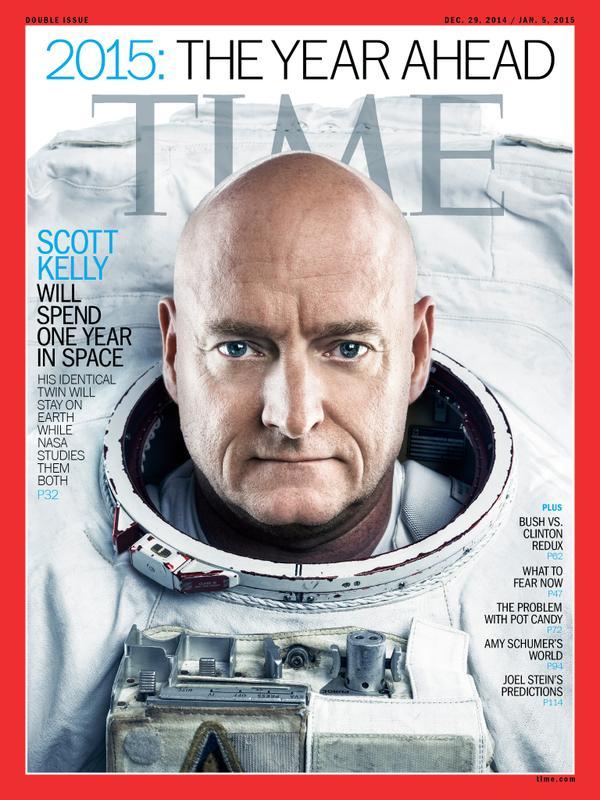
Biographical Data
SCOTT J. KELLY (CAPTAIN, USN, RET.)
NASA ASTRONAUT
PERSONAL DATA: Born February 21, 1964 in Orange, New Jersey. He has two children.
EDUCATION: Graduated from Mountain High School, West Orange, New Jersey, in 1982; received a Bachelor of Science degree in Electrical Engineering from the State University of New York Maritime College in 1987 and a Master of Science degree in Aviation Systems from the University of Tennessee, Knoxville, in 1996.
ORGANIZATIONS: Associate Fellow, Society of Experimental Test Pilots; Member, Association of Space Explorers
SPECIAL HONORS: Two Defense Superior Service Medals, Distinguished Flying Cross, Navy Commendation Medal, Navy Achievement Medal, two Navy Unit Commendations, National Defense Service Medal, Southwest Asia Service Medal, Kuwait Liberation Medal, Sea Service Deployment Ribbon, NASA Distinguished Service Medal, NASA Exceptional Service Medal, NASA Outstanding Leadership Medaltwo NASA Space Flight Medals, Russian Federation Medal for Merit in Space Exploration. Korolev Diploma from the Federation Aeronautique Internationale, 1999. Honorary Doctorate of Science degree from the State University of New York, 2008.
EXPERIENCE: Kelly received his commission from the State University of New York Maritime College in May 1987 and was designated a naval aviator in July 1989 at Naval Air Station (NAS) in Beeville, Texas. He then reported to Fighter Squadron 101 at NAS Oceana, Virginia Beach, Virginia, for initial F-14 Tomcat training. Upon completion of this training, he was assigned to Fighter Squadron 143 and made overseas deployments to the North Atlantic, Mediterranean Sea, Red Sea and Persian Gulf aboard the USS Dwight D. Eisenhower (CVN-69). Kelly was selected to attend the U.S. Naval Test Pilot School in January 1993 and completed training in June 1994. After graduation, he worked as a test pilot at the Strike Aircraft Test Squadron, Naval Air Warfare Center, Aircraft Division, Patuxent River, Maryland, flying the F-14 Tomcat and F/A-18 Hornet. Kelly was the first pilot to fly an F-14 with an experimental digital flight control system installed and performed subsequent high angle of attack and departure testing. He has logged over 8,000 hours in more than 40 different aircraft and spacecraft and has over 250 carrier landings. Kelly holds a United States Coast Guard Third Mate’s license. Kelly retired from the U.S. Navy in June of 2012.
NASA EXPERIENCE: Selected by NASA in April 1996, Kelly reported to the Johnson Space Center in August 1996. Following completion of training, he was assigned technical duties in the Astronaut Office Spacecraft Systems/Operations branch. A veteran of three space flights, Kelly has logged more than 180 days in space. He served as pilot on STS-103 in 1999 and was the Mission Commander on STS-118 in 2007. Following STS-103, Kelly served as NASA’s Director of Operations in Star City, Russia. He served as a backup crewmember for ISS Expedition 5 and as the Astronaut Office Space Station Branch Chief. Kelly also served as a Flight Engineer for ISS Expedition 25 and as the Commander of ISS Expedition 26. He currently serves as the International Space Station Operations Branch Chief within the Astronaut Office.
Kelly and cosmonaut Mikhail Kornienko have been selected to serve a one-year mission aboard the International Space Station in 2015. The goal of the mission is to understand how the human body reacts and adapts to the harsh environment of space. Data from the expedition will be used to reduce risks to the health of crewmembers as NASA prepares to advance space travel beyond low Earth orbit.
SPACE FLIGHT EXPERIENCE: STS-103 (December 19 to December 27, 1999) was an 8-day mission, during which the crew successfully installed new instruments and upgraded systems on the Hubble Space Telescope (HST). Enhancing HST scientific capabilities required three spacewalks (EVAs). The STS-103 mission was accomplished in 120 Earth orbits, traveling 3.2 million miles in 191 hours and 11 minutes.
STS-118 (August 8 to August 21, 2007) was the 119th space shuttle flight, the 22nd flight to the International Space Station (ISS), and the 20th flight for Endeavour. During the mission, Endeavour’s crew successfully added another truss segment, a new gyroscope and an external spare parts platform to the ISS. A new system that enables docked shuttles to draw electrical power from the station to extend visits to the outpost was successfully activated. A total of four EVAs were performed by three crewmembers. Endeavour carried approximately 5,000 pounds of equipment and supplies to the station and returned to Earth with approximately 4,000 pounds of hardware and equipment. Traveling 5.3 million miles in space, the STS-118 mission was completed in 12 days, 17 hours, 55 minutes and 34 seconds.
On October 7, 2010, Kelly launched aboard the Soyuz TMA-M spacecraft to serve a tour of duty on the ISS. He assumed command of Expedition 26 once the Soyuz TMA-19 undocked on November 24, 2010. After a 159 day stay aboard the ISS, Commander Kelly and Russian Flight Engineers Alexander Kaleri and Oleg Skripochka safely landed their Soyuz spacecraft on the Kazakhstan Steppe on March 16, 2011.
.
Biographical Data
.

KORNIENKO, MIKHAIL BORISOVICH
ROSCOSMOS TEST-COSMONAUT
514TH COSMONAUT OF THE WORLD
104TH COSMONAUT OF THE RUSSIAN FEDERATION
BIRTHPLACE AND DATE: Born 15 April, 1960, in Syzran, Kuibyshev region, Russia.
PERSONAL DATA: Married to Irina Anatolievna Kornienko (Savostina); daughter Natalia.
EDUCATION: Graduated from a secondary school in Chelyabinsk, Russia, in 1977; served in paratroops in 1978 – 1980; in 1981 to 1987 he studied at the Moscow Aviation Institute and graduated with an engineering degree (aircraft engine mechanical engineer).
EXPERIENCE: In 1980 Kornienko completed his military service and worked for the Moscow law enforcement agencies from 1980 to 1986. In 1986 started working for a mechanical engineering design bureau as a test engineer. In 1991-1995 he worked for commercial companies. In April 1995 Kornienko started working at the Energia Rocket/Space Corporation (RSC) as an engineer. He was responsible for technical documentation and software for testing and crew EVA training.
SPACEFLIGHT TRAINING: In February, 1998 Kornienko was selected as an Energia test cosmonaut candidate, and in 1999, following basic training at the Yu. Gagarin Cosmonaut Training Center, was qualified as a test cosmonaut.
From August 2001 to February 2003 Kornienko was assigned to the ISS 8 backup crew as an ISS flight engineer and Soyuz TM commander (for a launch on the Shuttle). Due to the Columbia tragedy the crew was reassigned.
From March 2003 to August 2005 participated in RS ISS advanced training. From September 2005 to January 2006 participated in ISS advanced training.
From February 2006 trained as ISS 15 bu engineer and Soyuz TMA bu flight engineer.
From March 2007 to August 2008 participated in RS ISS advanced training.
From August 2008 to April 2010 trained as an ISS 23/24 flight engineer and Soyuz TMA flight engineer.
SPACEFLIGHT EXPERIENCE: From April 2, 2010 to September 25, 2010 completed his first spaceflight as a Soyuz TMA-18 and ISS-23 flight engineer with cosmonaut A. Skvortsov and astronaut T. Caldwell-Dyson (NASA). Performed a spacewalk that lasted for 6 hours and 43 minutes. Kornienko has logged 176 days 1 hour and 18 minutes in space.
AWARDS: Golden Star of the Hero of the Russian Federation (April 12, 2011), Gagarin medal, Honorary citizen of Syzran (2010).
Quelle:NASA5038 Views
